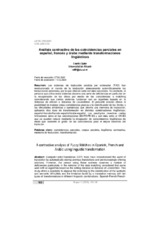Mostrar el registro sencillo del ítem
Análisis contrastivo de las coincidencias parciales en español, francés y árabe mediante transformaciones lingüísticas
| dc.contributor.author | Djabri, Souhila | |
| dc.date.accessioned | 2021-07-22T10:13:01Z | |
| dc.date.available | 2021-07-22T10:13:01Z | |
| dc.date.issued | 2020 | |
| dc.identifier.issn | 2255-3703 | |
| dc.identifier.uri | http://hdl.handle.net/10396/21520 | |
| dc.description.abstract | Los sistemas de traducción asistida por ordenador (TAO) han revolucionado el mundo de la traducción almacenando automáticamente las traducciones anteriores, por lo que ofrecen cada vez más soluciones. No obstante, la persona que utiliza estos sistemas observa una serie de deficiencias en particular en la recuperación de los datos por medio de las coincidencias o matching considerando que ciertos sistemas funcionan con un algoritmo basado en la distancia de edición o distancia de Levenshtein. El presente estudio ofrece la posibilidad de mejorar estas coincidencias gracias a la identificación de los límites o las dificultades sintácticas y semánticas que afronta una memoria de traducción, aplicando diez tipos de transformación en distintas combinaciones lingüísticas: español-francés/francés-español/árabe-español. Los resultados muestran ciertas limitaciones tanto en las combinaciones ES-FR/FR-ES y aún más entre el AR-ES que se pueden reducir mediante la integración de conocimientos lingüísticos de modo que aumente el grado de las coincidencias para el mayor beneficio del traductor. | es_ES |
| dc.description.abstract | Computer-aided translation (CAT) tools have revolutionized the world of translation by automatically storing previous translations and are increasingly offering solutions. However, the person using these systems observes a number of deficiencies particularly in the retrieval of the data matching considered that some work with an algorithm based on the editing distance or distance of Levenshtein. This study offers a possibility to improve the matching by the identification of the syntactic and semantic difficulties and the limitation faced by a translation memory with ten types of transformations in different linguistic combinations: Spanish-French/French-Spanish/Arabic-Spanish. The results show certain limitation in both ES-FR/FR-ES combinations and even more between AR-ES that can be reduced by integrating linguistic knowledge and increasing the matching level for the greatest benefit of the translator. | es_ES |
| dc.format.mimetype | application/pdf | es_ES |
| dc.language.iso | spa | es_ES |
| dc.publisher | UCOPress | es_ES |
| dc.rights | https://creativecommons.org/licenses/by/3.0/ | es_ES |
| dc.source | Skopos 11, 103-120 (2020) | es_ES |
| dc.subject | Coincidencias parciales | es_ES |
| dc.subject | Corpus paralelo | es_ES |
| dc.subject | Lingüística contrastiva | es_ES |
| dc.subject | Memoria de traducción | es_ES |
| dc.subject | Transformación | es_ES |
| dc.subject | Fuzzy matches | es_ES |
| dc.subject | Parallel corpora | es_ES |
| dc.subject | Comparative linguistics | es_ES |
| dc.subject | Translation memory | es_ES |
| dc.title | Análisis contrastivo de las coincidencias parciales en español, francés y árabe mediante transformaciones lingüísticas | es_ES |
| dc.title.alternative | A contrastive analysis of Fuzzy Matches in Spanish, French and Arabic using linguistic transformation | es_ES |
| dc.type | info:eu-repo/semantics/article | es_ES |
| dc.relation.publisherversion | https://www.uco.es/ucopress/ojs/index.php/skopos/index | es_ES |
| dc.rights.accessRights | info:eu-repo/semantics/openAccess | es_ES |

